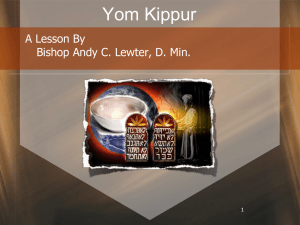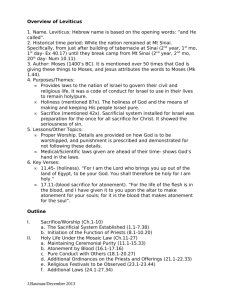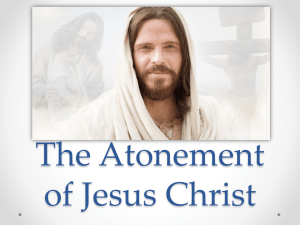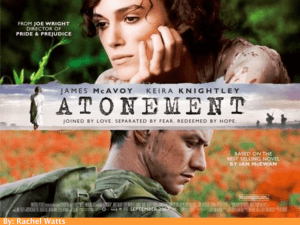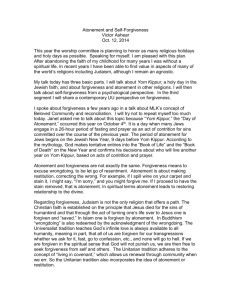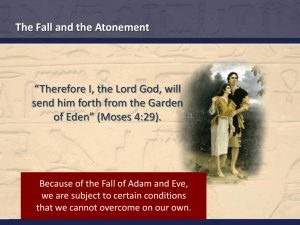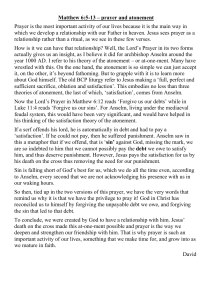Lesson
advertisement
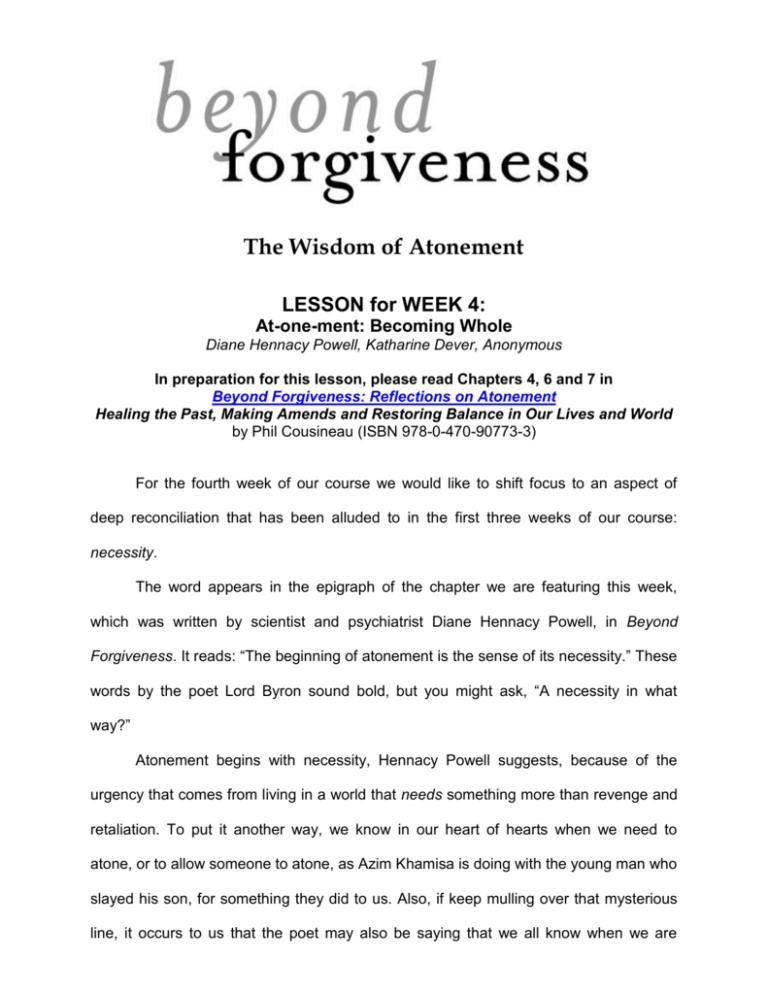
The Wisdom of Atonement LESSON for WEEK 4: At-one-ment: Becoming Whole Diane Hennacy Powell, Katharine Dever, Anonymous In preparation for this lesson, please read Chapters 4, 6 and 7 in Beyond Forgiveness: Reflections on Atonement Healing the Past, Making Amends and Restoring Balance in Our Lives and World by Phil Cousineau (ISBN 978-0-470-90773-3) For the fourth week of our course we would like to shift focus to an aspect of deep reconciliation that has been alluded to in the first three weeks of our course: necessity. The word appears in the epigraph of the chapter we are featuring this week, which was written by scientist and psychiatrist Diane Hennacy Powell, in Beyond Forgiveness. It reads: “The beginning of atonement is the sense of its necessity.” These words by the poet Lord Byron sound bold, but you might ask, “A necessity in what way?” Atonement begins with necessity, Hennacy Powell suggests, because of the urgency that comes from living in a world that needs something more than revenge and retaliation. To put it another way, we know in our heart of hearts when we need to atone, or to allow someone to atone, as Azim Khamisa is doing with the young man who slayed his son, for something they did to us. Also, if keep mulling over that mysterious line, it occurs to us that the poet may also be saying that we all know when we are broken and need to feel whole — at-one — again, to feel some peace of mind; likewise, we know when we have hurt others and need be at-one with them again. (Please read pages 51-53 for her insights into the growing need for atonement) PERSONAL REFLECTION: People have asked for centuries: What is it about atonement that can bring us peace? A CONCISE DEFINITION Diane Hennacy Powell, who has worked with survivors of genocide, prisoners, and women victimized by war, provides us with one of the most concise definitions of atonement that you will ever find. It goes straight to the heart of the book, which doesn’t aim to pit itself against forgiveness but rather to link it in a meaningful way to atonement. She combines the act of asking for forgiveness with a meaningful act of atonement. This means doing something that reveals one’s “contrition.” (Please read pages 51-52 in Beyond Forgiveness for Dr. Hennacy Powell’s concise distinction between theological and social atonement.) Contrition may seem like an old fashioned word, but it is a deft choice. It is a very old word, dating back to at least 1300, but its original meaning can still speak to us in a visceral way. It comes from the old Latin word contritus, which means, “worn out, ground to pieces.” Figuratively speaking, it means that our spirit has been crushed by something we’ve done that we regret, a misdeed, a betrayal, or even a sin. Crushed and feeling the compunction to do something about it. That is where, Dr. Hennacy Powell reminds us, that atonement comes in. It is the meaningful that proves our contrition. Or, to paraphrase the Dalai Lama, “If we find we cannot help others, the least we can do is to desist from harming them.” (Please read pages 53-55 in Beyond Forgiveness for further insights into the necessity of action and the factors that prevent many people from forgiving others, and then going beyond forgiveness to atonement.) Having worked with both victims of terrible violence, such as victims of war, and the perpetrators of such heinous acts, such as the Lost Boys of the Sudan, Dr. Hennacy Powell warns again of what she describes as “the capacity for intellectualization of our behavior can also produce endless layers of self-deception.” Which, don’t you think, is another way to say there is a time for contemplation, a time for thinking, a time for action, and in our case, a time for the wisdom of atonement. PERSONAL REFLECTION: Can we “think” ourselves out of the problem of guilt and shame? THE SECRET OF SECRETS For the nineteenth century spiritual teacher, Swami Vivekananda, “All differences in this world are of degree, and not of kind, because oneness is the secret of everything.” Without feeling at one, at peace, whole, we are in constant conflict with ourselves, and the world. To protect the sanctity of our inner life, we must have a deep sense of interconnectedness with others, and our ultimate oneness, which is threatened by unresolved conflicts but healed through atonement. Under this definition, our life of atonement is as a necessity in the search for what she calls “a higher level of consciousness,” if we are to cope with the steady reports of tragedy all around us, many of them committed in the name of peace or religion. The implications of this are profound: it is no use saying we are sorry if the confession is not accompanied by an offer to make things right, to rebalance a relationship that has gone awry. But what kind of atonement are we speaking about this week? Is it the theological atonement that means a kind of unity with God? Is it a form of redemption? PERSONAL REFLECTION: Do you feel that “necessity” is the appropriate word for the beginning or motivation for atonement? Have you ever felt the deep need to atone? THE PROCESS What anyone involved with either spiritual work or social action work soon learns is that any significant change takes time. Considering the urgency and necessity for atonement, the idea of a long process might sound contradictory. But it isn’t as much of a paradox as it might appear. Instead, Dr. Hennacy Powell points out, atonement is a process, often a long one, in the more violent cases, but still a journey that “enables us to become one, or whole again.” But how do we know when it is necessary to do something about an act we regret? Her listing of signposts along the way is almost painfully precise: “In other words, when we feel shame, guilt, anger, or hurt; we need to come to peace with ourselves, with others, and with whatever we believe to be God. After bad things happen, atonement can lift the perceived veil separating us from God or the Divine.” To view our reconciliation efforts as a process is similar to seeing it as an important part of our life journey, which suggests movement, rotation, and progress. Refer to Phil Cousineau’s Atonement Journey Wheel. (Read pages 55-56 in Beyond Forgiveness for clear insight into the process of atonement and its healing aspects.) PERSONAL REFLECTION: Does Diane Hennacy Powell’s idea of atonement as the act of “becoming one” resonate with you? THE BENEFITS OF ATONEMENT You may wonder if there are down to earth or practical benefits to atonement. Dr. Hennacy Powell believes so. She writes in Beyond Forgiveness: “Every day in the news we see more examples of violations and wrongdoing that calls for atonement, which is recognized in our depths by the signals thrown up from our soul or spirit: Shame, guilt, embarrassment.” PERSONAL REFLECTION: Have you seen a recent example of wrongdoing in the news that calls for atonement? REFUSAL TO FORGIVE While forgiveness and atonement ring true and sound noble, we soon come to realize that many people simply refuse to forgive, or admit there are amends to be made. In one of the most powerful passages in Beyond Forgiveness, Dr. Hennacy Powell reveals her insights from her life’s work as a psychiatrist working with victims– and perpetrators–of violent crimes that can help us understand how people can come to believe their own lies and rationalizations. As someone who has worked with both deeply traumatized victims and perpetrators of the worst crimes, she reveals how the lack of forgiveness and atonement can “perpetuate our suffering” if we hold onto our anger, allow our rage to fester, or worse, redirect it toward revenge. (Please read 53-54 in Beyond Forgiveness to learn about the various factors that may have coerced offenders to commit their crimes, including mental illness, drug addiction, or torture.) PERSONAL REFLECTION: Do you know someone who refuses to forgive, who holds onto resentments and anger? Do you know someone who is stuck in limbo—refusing to take the next step and move forward to initiate atonement? Is there any way you can help them? THE URGENCY FOR HEALING Do you feel the urgency yet? If not, consider this marvel of language, as Dr. Hennacy Powell points out. The English words health, heal, whole and holy derive from the Old English word hál. We are most healthy when we are healed, which is a kind of holy process, the process of becoming whole. This is only possible if we accept that healing is at least partly based on a reasonable understanding of suffering, which is at the core of human existence, and as we all have painfully learned, “often entails a disruption of wholeness—a disruption of what is vital and sacred in someone’s life.” (Please see page 60 in Beyond Forgiveness for further explication of health and atonement.) PERSONAL REFLECTION: Does this connection of “health, holiness, and wholeness” resonate with you? Is healing a spiritual process for you? ACKNOWLEDGEMENT Katherine Dever Katharine Dever is a therapist and life coach working in the United Kingdom. In her essay in Beyond Forgiveness (Chapter 6), she tells of two different kinds of abuse that have required atonement. The first is of a personal nature, and the second is a story of abuse against nature. This story against nature is about the inspiring Pablo Fajardo, from Ecuador. As a teenager he worked for one of the foreign oil companies operating there. When he realized that the company was poisoning the rivers and skies of his own beloved lands he objected and was fired. Undeterred, he became a lawyer and promptly filed suit against the company. Dever describes her amazement at Fajardo’s courage and vision, and especially his embodying the possibility of atoning for the way in which we have lost our connection to the land, to nature, to Mother Earth. As she writes, “Atonement is not just saying sorry. It is a process of acknowledging, and then healing the damage that has been done on our behalf, of going an extra mile to take action—to make a move, a reparation of some kind—in order to make amends.” This story is inspiring and humbling. It can serve as a kind of challenge to all of us to gain courage to face even the seemingly insurmountable problems of our times and to do what needs to be done to rebalance the imbalance, to restore our natural world. Through her story we learn that by taking even small steps, we can all make amends and redirect our behavior, day by day, on our spiritual journey through life. PERSONAL REFLECTION: After acknowledging a wrong, have you ever felt emboldened to play David against the Goliaths of the world, to atone for the wrongs of our time in history? THE TWELVE STEPS Anonymous For those of you who are not familiar with the element of atonement in traditional Twelve Step programs, it may come as a surprise that its presence is so deeply felt within them. However, it is very likely that people close to you, friends and family, have been or are involved in one of the many Twelve Step programs (there are over 40 different twelve-step programs tailored to the recovery needs of that many addictive, compulsive or behavioral problems), so a little reminder here may bring you some insight into their experiences. (Please refer to Chapter 7, pages 91-100 in Beyond Forgiveness.) In the spirit of anonymous contributions and healing efforts that mark Twelve Step programs, one of the essayists in Beyond Forgiveness has written an eloquent chapter that explains the connection of Twelve Step programs to what we are calling here The Atonement Journey. Addicts may lie, steal, and even commit violence to get their hands on the drug they’re addicted to. Shattered relationships lie in their wake. When addicts turn to twelve-step recovery programs, they are embarking on a serious commitment to a practice. The description by Anonymous testifies that the power of these programs lie in the fact that they help “to dissolve fear, anger, resentment.” (Review pages 95-97 in Beyond Forgiveness.) That’s powerful all by itself, but our contributor adds a unique element in reminding us that, in theory, atonement should happen from both directions if a deeper reconciliation is truly desired. From the spiritual perspective of human experience, they must meet in the middle, as equals—a reminder of what Azim Khamisa meant when he said every crime has two victims. Anonymous also reminds us of the deep insights provided by Step Eight, which is to make a list of those we may have offended, and Step Nine, which is, in the spirit of Beyond Forgiveness, is to take the next step and actually make amends. (Review pages 91-94 in Beyond Forgiveness.) Anonymous adds that it is crucial to the twelvestep process to take a personal inventory every evening, in line with many other spiritual and self-help disciplines, such as Michael Bernard Beckwith’s and Arun Gandhi’s nightly prayer practices in the Lessons for Week 1 and Week 2. FOR PERSONAL REFLECTION: Review the Atonement Journey Wheel. What do you think about the parallels between the Atonement Journey, and the guiding principles of the Twelve Step programs? How are they similar? How are they unique? Which journey are you on? Where are you in the journey? FORGIVENESS PRACTICES Adapt a practice from the Twelve Steps: Make a list of the people you have wronged. Make another, corresponding list, detailing what acts of atonement you might make to attempt to clean the slate for each person. As Michael Bernard Beckwith says in Lesson 1: “Are there amends that need to be made? Apologies to offer?” Take action. IN PRACTICE, A REVIEW Every week of our course we review the Seven Practices of Atonement, which are based on the life work of the fifteen contributors to the companion book to this study series, Beyond Forgiveness: Reflections on Atonement. Together, they can lead to a genuine change of heart, and can lead to a more compassionate life for everyone who practices them: Seven Practices of Atonement 1) Acknowledge the hurt, the harm, the wrong 2) Offer apologies, ask for forgiveness 3) Try to make amends commensurate with the harm done 4) Help to clear the conscience of the offender 5) Relieve the anger and shame of the victim 6) Practice compassion for victim and perpetrator alike 7) Establish a spiritual practice of prayer or meditation Together, these practices reveal the journey-like quality of the work that links forgiveness with atonement and healing. Additionally, here also some spiritually uplifting things you can do that also help us reconnect and heal. 1) If possible, attend counseling, mediation, religious services or a Twelve Step Program with the person or people you want to reconcile with. Find the support you need. 2) Use the arts as a healing tool: See a play, a movie, or read a novel, with themes of atonement and reconciliation. Discuss with your study group, friends, or book group. Write your reflections in a journal. 3) Write a heartfelt letter to the person you desire to reconcile with; reestablish communication as honestly as possible. THE NEXT LEVEL Let’s keep exploring the mysterious process of moving through and then beyond forgiveness, to the next stage, the next level of compassion-centered reconciliation. QUESTIONS FOR GROUP DISCUSSION 1. Do you feel more confident about embracing the spiritual practice of atonement, not only in your mind or through your intellect, but also in your body, through your emotions, your soul and spirit? 2. Reflect on the word “necessity.” Does the word move you in body, mind, or spirit? 3. Have you ever hurt from your lack of peace with yourself, or your separation from your understanding of the Divine? 4. Are you ever disturbed by the lack of emotional healing that comes with ordinary forgiveness declarations from family and loved ones? 5. Why do survivors of crime or trauma often have no inclination to forgive? (Because they feel that doing so would be letting others get away with what they had done.) 6. Are you willing to allow others to see and feel your compassion? 7. How can atonement relieve someone plagued by a guilty conscience? 8. What can you imagine the “karmic consequences” might be of not going beyond forgiveness to atonement? 9. Do you agree that people who have committed some wrongdoing need a chance to repair the situation? 10. What can we each do to awaken to our oneness and to the divinity within us all? A CONTEMPLATIVE QUOTE “To safeguard democracy the people must have a keen sense of independence, self-respect, and their oneness.” — Mohandas Gandhi AFFIRMATIONS Select those that resonate for you I am connected to a higher level of consciousness. I am picking up the pieces of my life. I am making amends to those I have harmed. I affirm that I will whatever it takes to dissolve my negative feelings. I affirm the goodness of my personal journey. I affirm the good intentions of all those striving to make a difference in the world. I am a journey toward wholeness. I am on the atonement journey—it encompasses my heart and my soul, my mind and my intellect, my emotions and my imagination. RESOLUTIONS I vow to forgive myself even for my worst acts. I promise to follow up those acts of self-forgiveness with acts of atonement. I will allow others to make amends to me if they hurt or betrayed me. If I am caught up in resentment, I will do my best to let it go so I can live in peace. I resolve to meet people halfway in all my conflicts, to give a little and to accept their attempts to meet me in the middle. I resolve to be in service to my friends, family, community, church or country. SUGGESTED VIDEO CLIPS Dr. Diane Hennacy Powell works with victims of extreme trauma, such as the “Lost Boys of Sudan.” To gain insight, watch this PBS POV film clip http://www.pbs.org/pov/lostboysofsudan/ or this news story about these survivors of civil war: http://www.youtube.com/watch?v=4kQSg0z6vEA. Some insight into Step Nine, “making direct amends” of the Twelve Steps from Sobriety Television: http://www.youtube.com/watch?v=OBqur7rbhSE Consider watching “My Name is Bill W.,” the award-winning Hallmark Hall of Fame movie about the founder of AA. NOTE: These study course materials were prepared by Phil Cousineau, and were created to be used hand-in-hand with the book, Beyond Forgiveness: Reflections on Atonement, with permission of the book’s publisher, JosseyBass, a Wiley Imprint. Copyright © 2011 by Phil Cousineau and Richard J. Meyer.
